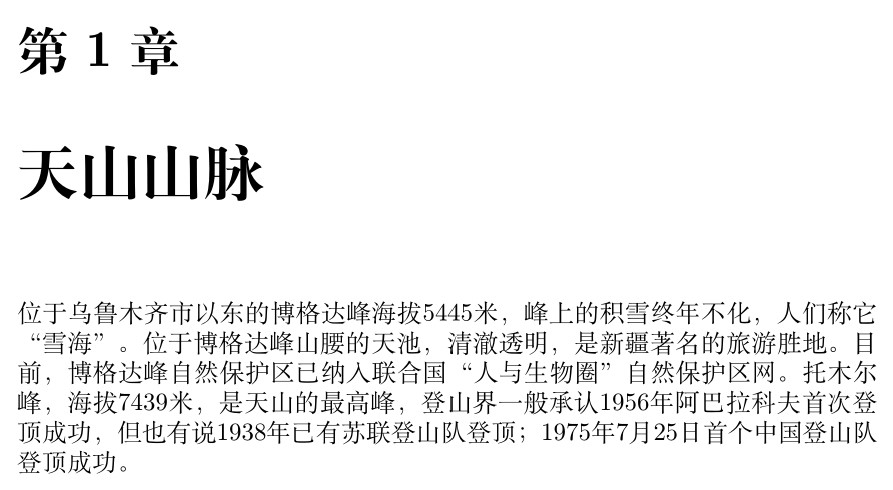Chinese
Improve this page! Feel free to draft a pull request on GitHub.
Search this site for more on Chinese.
The Chinese language is available for luatex and xetex. With the
former, both renderers (Node and Harfbuzz) are fine.
Note the best option is usually to resort to a dedicated framework like
CTeX, CJK or
ChineseJFM. However, for simple
documents in horizontal writing, as well as a few words or sentences in
a multilingual document, babel should be enough.
Here is a short example:
\documentclass{book}
\usepackage[chinese, provide=*]{babel}
\babelfont{rm}{FandolSong}
\begin{document}
\chapter{天山山脉}
位于乌鲁木齐市以东的博格达峰海拔5445米,峰上的积雪终年不化,人们称它“雪海”。位于博格达峰山腰的天池,清澈透明,是新疆著名的旅游胜地。目前,博格达峰自然保护区已纳入联合国“人与生物圈”自然保护区网。托木尔峰,海拔7439米,是天山的最高峰,登山界一般承认1956年阿巴拉科夫首次登顶成功,但也有说1938年已有苏联登山队登顶;1975年7月25日首个中国登山队登顶成功。
\end{document}

Line breaking and spacing
In LuaTeX a line breaking mechanism has been devised, based on (but not
strictly following) the Unicode algorithm. Spacing is controlled with
the transform spacing.basic. See What’s new in babel
25.6
for details.
Rules are harcoded in XeLaTeX, although those based on the ‘interchar’
mechanism have to be activated
explicitly
with interchar=linebreak.basic when importing with \babelprovide or
the option provide. (Note they are active by default with XeTeX, but
not with XeLaTeX.)
Justification in both engines is controlled by a couple of options in
\babelprovide.
intraspacesets the inner spaces in em units (so,0 .1 0is 0em plus .1em). The em unit applied is that of the current text (more precisely, the previous glyph).intrapenaltysets the inner penalty of the breaking opportunities.
There is in addition the posibility to change globally the line breaking class, with, for example:
\babelcharproperty{`“}{linebreak}{op}
\babelcharproperty{`”}{linebreak}{cl}
For the meaning of these codes, see the Unicode Standard Annex #14: Line Breaking Properties.
Counters
With luatex there are two ways to map Arabic to
Chinese numerals, passed as option to \babelprovide:
maparabicdoes it at the TeX level, by redefining\arabic. Note the form written to the auxiliary files is the converted one. It works withxetex, too.mapdigitsdoes it at the engine level. This is usually the preferred method.
To perform this conversión, use the following settings:
\usepackage[chinese, provide=*]{babel}
\babelprovide[mapdigits]{chinese} % or alternatively maparabic
In addition, the following counters are predefined:
cjk-earthly-branch= 子 丑 寅 卯 辰 巳 午 未 申 酉 戌 亥cjk-heavenly-stem= 甲 乙 丙 丁 戊 己 庚 辛 壬 癸circled.ideograph= ㊀ ㊁ ㊂ ㊃ ㊄ ㊅ ㊆ ㊇ ㊈ ㊉parenthesized.ideograph= ㈠ ㈡ ㈢ ㈣ ㈤ ㈥ ㈦ ㈧ ㈨ ㈩fullwidth.lower.alpha= a b c d e f g h i j k l m n o p q r s t u v w x y zfullwidth.upper.alpha= A B C D E F G H I J K L M N O P Q R S T U V W X Y Zdate.day= 初一 初二 初三 初四 初五 初六 初七 初八 初九 初十 十一 十二 十三 十四 十五 十六 十七 十八 十九 二十 廿一 廿二 廿三 廿四 廿五 廿六 廿七 廿八 廿九 三十
A further counter is date.sexagenary, loaded only when importing with \babelprovide or
the option provide.
Calendar
Dates with the tradicional calendar can be printed. By default the year is numeric, but there is a variant with the sexagenary cycle. See What’s new in babel 3.94.